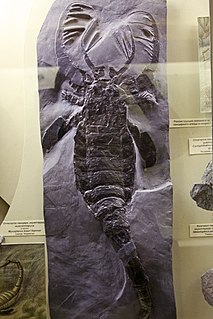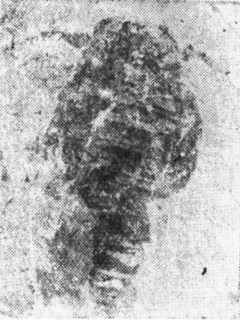
Eurypterus is an extinct genus of eurypterid, a group of organisms commonly called "sea scorpions". The genus lived during the Silurian period, from around 432 to 418 million years ago. Eurypterus is by far the most well-studied and well-known eurypterid and its fossil specimens probably represent more than 90% of all known eurypterid specimens.

Megalograptus is a genus of eurypterid recovered from deposits of Ordovician age. The genus is classified as part of the Megalograptidae family and contains five species, four from Ohio and one from Virginia.

Mixopterus is a genus of eurypterid, an extinct group of aquatic arthropods. Fossils of Mixopterus have been discovered in deposits from Late Silurian age, and have been referred to several different species. Fossils have been recovered from two continents; Europe and North America.

Carcinosoma is a genus of eurypterid, an extinct group of aquatic arthropods. Fossils of Carcinosoma are restricted to deposits of late Silurian age. Classified as part of the family Carcinosomatidae, which the genus lends its name to, Carcinosoma contains seven species from North America and Great Britain.

Alkenopterus is a genus of prehistoric eurypterid classified as part of the family Onychopterellidae. The genus contains two species, A. brevitelson and A. burglahrensis, both from the Devonian of Germany.

Brachyopterus is a genus of prehistoric eurypterid of the family Rhenopteridae. It is one of the earliest known eurypterids, having been recovered from Middle Ordovician deposits in Montgomeryshire, Wales. Though other species have been assigned to it in the past, Brachyopterus is today recognized as containing one valid species, B. stubblefieldi.

Ctenopterus is a genus of prehistoric eurypterid of the family Stylonuridae. It contains only one species, Ctenopterus cestrotus from the Early Silurian of Otisville, New York.

Nanahughmilleria is a genus of eurypterid, an extinct group of aquatic arthropods. Fossils of Nanahughmilleria have been discovered in deposits of Devonian and Silurian age in the United States, Norway, Russia, England and Scotland, and have been referred to several different species.

Onychopterella is a genus of predatory eurypterid, an extinct group of aquatic arthropods. Fossils of Onychopterella have been discovered in deposits from the Late Ordovician to the Late Silurian. The genus contains three species: O. kokomoensis, the type species, from the Early Pridoli epoch of Indiana; O. pumilus, from the Early Llandovery epoch of Illinois, both from the United States; and O. augusti, from the Late Hirnantian to Early Rhuddanian stages of South Africa.

Holmipterus is a genus of eurypterid, an extinct group of aquatic arthropods. Fossils of Holmipterus have been discovered in deposits of the Sheinwoodian age in Europe. It only contains one species, which is in turn the type species, H. suecicus, from Gotland, Sweden. The generic name honors Gerhard Holm, a Swedish paleontologist whose work in the arthropods remains as a model to follow.

Tylopterella is a genus of eurypterid, a group of extinct aquatic arthropods. Only one fossil of the single and type species, T. boylei, has been discovered in deposits of the Late Silurian period in Elora, Canada. The name of the genus is composed by the Ancient Greek words τύλη (túlē), meaning "knot", and πτερόν (pteron), meaning "wing". The species name boylei honors David Boyle, who discovered the specimen of Tylopterella.

Echinognathus is a genus of eurypterid, an extinct group of aquatic arthropods. Classified as part of the family Megalograptidae, the genus contains one only species, E. clevelandi, whose fossils have been found in deposits from the Katian age of the Late Ordovician period of New York. The name of the species, clevelandi, honors William N. Cleveland, who found the specimens that were used for the description of Echinognathus.

Stylonurus is a genus of prehistoric eurypterid of the family Stylonuridae. The genus contains three species: Stylonurus powriensis from the Devonian of Scotland, Stylonurus shaffneri from the Devonian of Pennsylvania and Stylonurus perspicillum from the Devonian of Germany.

Orcanopterus is a genus of a eurypterid classified as part of the family Waeringopteridae. The genus contains one species, O. manitoulinensis, from the Ordovician of Manitoulin, Canada.

Unionopterus is a genus of eurypterid, an extinct group of aquatic arthropods commonly known as "sea scorpions". Fossils have been registered from the Early Carboniferous period. The genus contains only one species, U. anastasiae, recovered from deposits of Tournaisian to Viséan stages in Kazakhstan. Known from one single specimen which was described in a publication of Russian language with poor illustrations, Unionopterus' affinities are extremely poorly known.

The Mixopteridae are a family of eurypterids, an extinct group of chelicerate arthropods commonly known as "sea scorpions". The family is one of two families contained in the superfamily Carcinosomatoidea, which in turn is one of the superfamilies classified as part of the suborder Eurypterina.

The Rhenopteridae are a family of eurypterids, an extinct group of chelicerate arthropods commonly known as "sea scorpions". The family is the only family currently contained in the superfamily Rhenopteroidea, one of four superfamilies classified as part of the suborder Stylonurina.

Pentecopterus is a genus of eurypterid, an extinct group of aquatic arthropods. Fossils have been registered from the Darriwilian age of the Middle Ordovician period, as early as 467.3 million years ago. The genus contains only one species, P. decorahensis, that is the oldest known eurypterid, surpassing other Ordovician eurypterids, such as Brachyopterus, in age by almost 9 million years. The generic name derives from the penteconter, a warship from ancient Greece, and the suffix -pterus, which means "wing" and is often used in other genus of eurypterids. The specific name refers to Decorah, Iowa, where Pentecopterus was discovered.

Adelophthalmidae is a family of eurypterids, an extinct group of aquatic arthropods. Adelophthalmidae is the only family classified as part of the superfamily Adelophthalmoidea, which in turn is classified within the infraorder Diploperculata in the suborder Eurypterina.

Eurypterina is one of two suborders of eurypterids, an extinct group of chelicerate arthropods commonly known as "sea scorpions". Members of the suborder are collectively and informally known as "eurypterine eurypterids" or "eurypterines". They are known from fossil deposits worldwide, though primarily in North America and Europe.




















